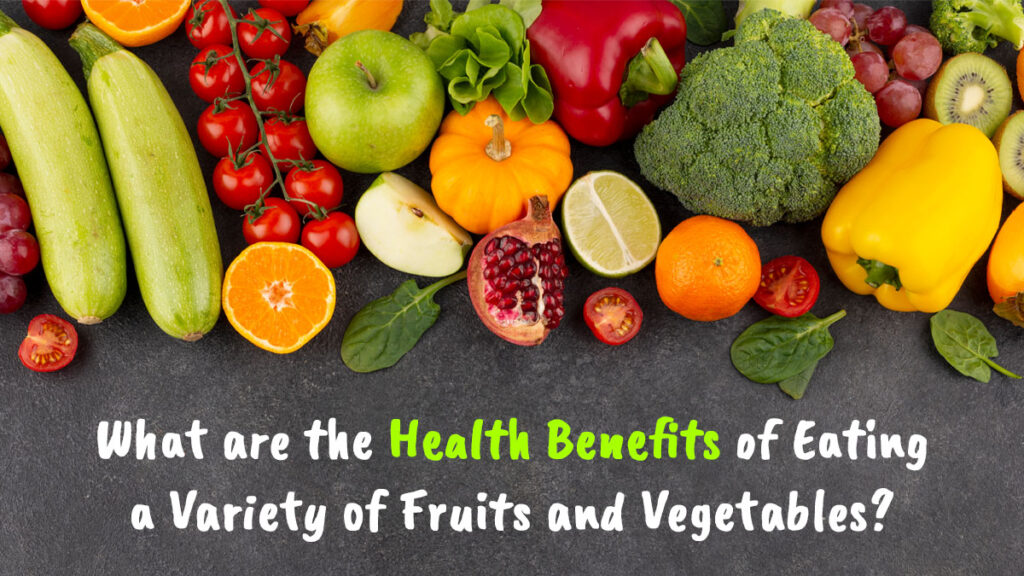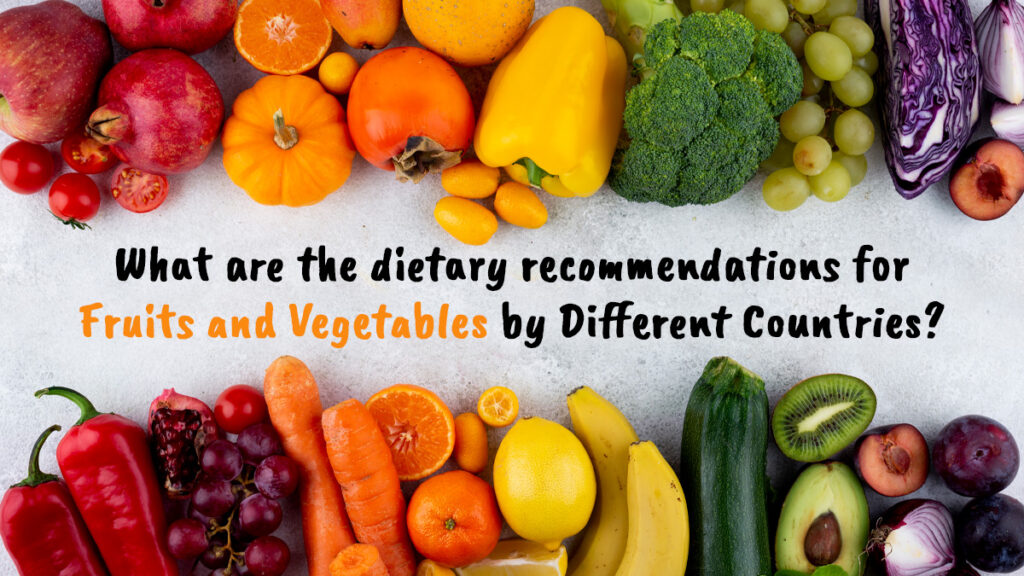A large percentage of Americans don’t quite reach the suggested goal of having 5 servings of fruits and vegetables daily. That’s a big chunk! But here’s the good news: boosting your health doesn’t have to mean big changes. A simple trick? Swap those heavy sides for steamed veggies or pick an apple and yogurt for breakfast instead of that pastry at your local café.

- How much Vegetable and Fruits we should take according to studies?
- What are the dietary recommendations for Fruits and Vegetables by Different Countries?
- What are Health Benefits of a diet rich with Fruits and Vegetables?
- What the tips are for eat more Fruits and Vegetables Every Day?
- Our Other Latest Articles
- When we should consume Fruits and Vegetable throughout the day?
Everybody knows fruits and veggies are super healthy! The experts suggest filling half your plate with them, and for a good reason. They’re a mix of plant foods, each bringing different good stuff like vitamins, fiber, and special chemicals that fight off bad stuff in your body.
They’re not just for veggie lovers; they’re for everyone! These plant foods give your body a bunch of vitamins and minerals, and new studies show how they help prevent big diseases like heart issues and cancer. And get this – low levels of these special nutrients in your blood might raise your chances of getting sick. So, adding more of these colorful foods is like a superhero move for your health!”
How much Vegetable and Fruits we should take according to studies?
According to various dietary guidelines and studies, the recommended intake of fruits and vegetables varies depending on factors such as age, sex, and individual needs. However, a common guideline is to aim for around 5 to 9 servings of fruits and vegetables per day. This generally translates to approximately 2 to 2.5 cups of fruits and 2.5 to 3 cups of vegetables daily for adults within a 2,000-calorie diet.
The emphasis is often placed on consuming a variety of fruits and vegetables of different colors and types to ensure a diverse intake of nutrients, vitamins, minerals, and antioxidants. These recommendations serve as a guide to promote overall health and reduce the risk of chronic diseases.
What are the dietary recommendations for Fruits and Vegetables by Different Countries?
Different countries have their own dietary guidelines regarding the recommended intake of fruits and vegetables. Here are some examples:

- United States: The Dietary Guidelines for Americans suggest that adults consume 1.5 to 2 cups of fruit and 2 to 3 cups of vegetables per day, depending on age, sex, and level of physical activity.
- United Kingdom: The UK’s Eatwell Guide advises consuming at least 5 portions of a variety of fruits and vegetables per day, which roughly equals to about 400 grams.
- Australia: The Australian Dietary Guidelines recommend adults consume at least 2 serves of fruit and 5 serves of vegetables daily, with specific recommendations for different age groups.
- Canada: Canada’s Food Guide suggests adults aim for 7 to 10 servings of fruits and vegetables daily, with an emphasis on variety and choosing whole fruits and vegetables more often than juice.
- World Health Organization (WHO): The WHO recommends consuming at least 400 grams (or 5 servings) of fruits and vegetables per day to reduce the risk of chronic diseases.
What are Health Benefits of a diet rich with Fruits and Vegetables?
Fruits and veggies aren’t side dishes—they’re like health superheroes! They’re full of good stuff like vitamins, minerals, and antioxidants that fight diseases, keep your heart healthy, and help with weight. They’re great for your tummy, make your skin glow, and boost your body’s defenses. Eating different fruits and veggies gives you 10 awesome health perks, so make sure to have them every day!
ALSO READ: Why Chicken Noodle soup best for the common cold during winters?
- Nutrient-Rich: Fruits and vegetables are packed with essential vitamins, minerals, and antioxidants vital for overall health and well-being.
- Heart Health: They contribute to heart health by reducing the risk of heart disease, thanks to their fiber content and various heart-healthy nutrients.
- Weight Management: Their high fiber content makes them filling while being low in calories, aiding in weight management by promoting fullness and reducing overall calorie intake.
- Digestive Health: The fiber in fruits and vegetables supports a healthy digestive system, prevents constipation, and maintains gut health.
- Disease Prevention: Regular consumption is linked to a lower risk of chronic diseases such as certain cancers, diabetes, and obesity.
- Improved Skin: The vitamins and antioxidants in these foods contribute to healthier skin by protecting against oxidative damage and supporting collagen production.
- Boosted Immunity: Nutrients like vitamins A, C, and E, along with minerals like zinc and selenium, support a robust immune system, helping the body defend against illnesses and infections.
- Better Vision: Certain fruits and vegetables, especially those high in vitamin A and lutein, are beneficial for eye health and may reduce the risk of age-related macular degeneration.
- Hydration: Many fruits and vegetables have high water content, contributing to overall hydration, which is essential for various bodily functions.
- Anti-Inflammatory Properties: Some fruits and vegetables contain compounds that have anti-inflammatory effects, potentially reducing inflammation in the body and lowering the risk of inflammatory diseases.
What the tips are for eat more Fruits and Vegetables Every Day?
Here are some tips to increase your intake of fruits and vegetables:
- Start Gradually: Begin by adding an extra serving of fruits or vegetables to one meal a day. Gradually increase the portions or frequency over time.
- Variety is Key: Experiment with different types of fruits and vegetables. Explore various colors, textures, and flavors to keep your meals exciting.
- Snack Wisely: Keep chopped fruits or veggies readily available for snacks. Carrot sticks, apple slices, or cherry tomatoes make convenient and healthy snack options.
- Include in Every Meal: Incorporate fruits and vegetables into every meal. Add berries to breakfast cereal, include a salad with lunch or dinner, and include veggies in pasta sauces or stir-fries.
- Explore New Recipes: Look for recipes that showcase fruits and vegetables in interesting ways. Smoothies, salads, soups, and grilled veggies offer a range of delicious options.
- Dips and Sauces: Pair vegetables with healthy dips like hummus, guacamole, or Greek yogurt-based sauces to make them more appetizing.
- Set a Goal: Challenge yourself to eat a certain number of servings of fruits and vegetables daily. Track your progress to stay motivated.
- Make it Colorful: Aim for a variety of colors on your plate. Different colors often indicate different nutrients, so a colorful plate means diverse nutritional benefits.
- Community Support: Join groups or communities focused on healthy eating. Sharing experiences and recipes can provide inspiration and motivation.
When we should consume Fruits and Vegetable throughout the day?
Consuming fruits and vegetables throughout the day can be beneficial for maintaining a balanced diet and maximizing their nutritional benefits. Here’s a general guide on when to include them:
ALSO READ: Foods that Increase Metabolism and Burn Fat
- Breakfast: Add fruits like berries, bananas, or citrus fruits to your breakfast. You can have them fresh, in smoothies, or as toppings on cereal or yogurt.
- Mid-Morning Snack: Have a piece of fruit or some cut-up vegetables as a mid-morning snack to keep you energized until lunch.
- Lunch: Include a salad or a side of vegetables with your lunch. Add various veggies to sandwiches, wraps, or as part of your main meal.
- Afternoon Snack: Another opportunity to have a serving of fruits or veggies to curb hunger and provide essential nutrients.
- Dinner: Incorporate a variety of vegetables into your dinner. They can be steamed, roasted, stir-fried, or served as a side dish or salad alongside your main course.
- Evening Snack: Opt for a light snack like sliced apples with nut butter, carrot sticks, or a small serving of fruit to satisfy evening cravings.




